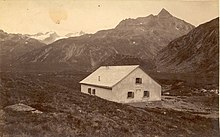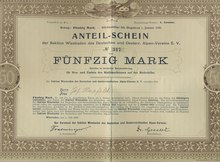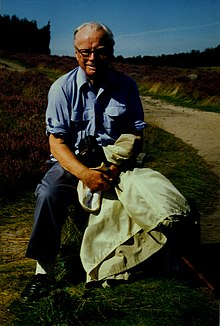Wiesbaden section of the German Alpine Club
| Wiesbaden section of the German Alpine Club (DAV section Wiesbaden) |
|
|---|---|

|
|
| purpose | Refuge operation, mountain trail maintenance & leisure activities |
| Chair: | Uwe Goerttler |
| Establishment date: | March 28, 1882 |
| Number of members: | 5414 (as of March 2020) |
| Seat : | Wiesbaden , Hesse |
| Website: | DAV-Wiesbaden.info |
The Wiesbaden section of the German Alpine Club ( DAV section Wiesbaden for short ) is one of the larger sections of the German Alpine Club and the largest sports club in Wiesbaden with 5414 members (as of March 2020) .
Section history
Difficult start
At the beginning of 1882, some enthusiastic friends of the Alps came up with the idea of founding a Wiesbaden section of the German and Austrian Alpine Association (DuÖAV).
On March 28, 1882, just thirteen years after the founding of the DuÖAV in Munich , seven gentlemen met in Wiesbaden and “constituted themselves in a unanimous resolution as the Wiesbaden section”. They elected the police director Dr. Hugo Karl Klemens von Strauss and Torney.
The first years of the new section were difficult. The chairmen changed quickly and funds were tight. In addition, the money collected for building a hut in 1882 and 1885 was donated to victims of severe weather disasters in the Alps.
Construction of the Wiesbadener hut
After several half-hearted attempts to find a work area in the Alps - e.g. B. near Hintertux in the Zillertal - the hut plans became concrete in 1891: The new chairman Dr. Ludwig Kaiser brought a breath of fresh air into the life of the section and intensified the search for a suitable place for his own hut, as he saw this as essential for the existence and growth of the section.
Several members had roamed the area of the Silvretta and in 1893 the general assembly decided to build the Wiesbadener hut in upper Vermunt at the foot of the Piz Buin . The section members signed a non-interest-bearing loan of 7,500 marks. After the contract was signed with the then independent municipality of Ardez in the Lower Engadine as the landowner and the postman and innkeeper JM Mattle from Galtür as the general contractor, the hut was built according to the plans of the section member, Government Builder Haeuser.
On August 21, 1896, the Wiesbadener Hütte - a utility room and three rooms with a total of 16 beds - was inaugurated. Around 85 people attended the inauguration and emptied 100 bottles of Rhine wine for the good of the new hut.
Veesenmeyer era
After Ludwig Kaiser had been transferred to Kassel on a professional basis, the section elected the Protestant pastor Emil Veesenmeyer as its new chairman in 1901 - he remained so until 1924. In his first year in office, the general assembly of the DuÖAV was held from September 4 to 9, 1901. 100 German and 29 Austrian sections came to Wiesbaden, 914 festival visitors experienced a festival performance in the theater, the general meeting in the Kurhaus and, as the grand finale, a trip to the Rhine with a ceremony at the Niederwald monument .
In the same year an expansion of the Wiesbadener Hütte was planned, which was inaugurated in August 1903. The landlord and mountain guides stayed in the old hut, while the new building created twelve double rooms and a large mattress store for a total of 37 "tourists", "so that the hut will now meet all requirements for the foreseeable future and ... has become exemplary in terms of furnishings and management".
The good economic development and the increasing number of members ensured that the section was doing better and better economically - and the board was looking for new fields of activity. He found what he was looking for in the direct vicinity of the Wiesbadener Hütte. The Vorarlberg section did not see itself financially in a position to carry out the necessary renovation of the Madlenerhaus . After initially secret, then open negotiations, the Wiesbaden section was able to take over the house on July 19, 1906 for 2,000 marks - combined with the obligation to expand it and keep the name.
The renovation, for which the section took out a 20,000 mark interest-free loan from its members, turned out to be difficult at times. In 1908 the new roof was torn down by a foehn storm and thrown 40 meters away. The renovation could still be inaugurated on June 12, 1909. Eight double rooms and a 14-person warehouse were newly created, the old hut was converted into guest and utility rooms based on the model of the Wiesbadener hut.
First World War and Reconstruction
The age of winter tourism had begun in the Alps. In 1911 a snowshoe department was founded in the section. The section also continued to do well financially. By early 1914, all debts related to the renovation of the Wiesbadener hut had been paid off. But the outbreak of the First World War put an end to the expansion of the section.
In the next four years, numerous section members were at the front, 17 of whom lost their lives. The huts were in the indirect war zone and therefore could not be visited - and of course did not bring any income. Section life almost came to a standstill. The 1918 Annual General Meeting had to be postponed until next spring, as there was no heatable restaurant.
At the end of the war, the two huts were almost completely looted, a suitcase with laundry and some blankets delivered to be dyed were the only things that the section had left of the interior.
Reconstruction of the huts began in 1920, but it was not until the summer of 1923 that it was again possible to speak of orderly operation. The number of mountain tourists increased steadily, especially in winter. In 1924 the section instructed both tenants to manage the huts in winter too.
Weimar Republic and National Socialism
The politically troubled times of the Weimar Republic were hardly noticeable in the life of the section, but affected the main association. They reached their climax in the affair surrounding the exclusion of the Donauland section , in which mainly Jewish alpinists had come together. In an extraordinary general meeting in 1924, a large majority of the sections voted for the exclusion - including Wiesbaden. As a result, all 14 Jewish members left the Wiesbaden section at the beginning of 1925.
The large number of visitors made further modifications to the huts necessary. The Wiesbadener Hütte was extended in two directions in 1925 and 1926 and then offered 80 beds, albeit with very cramped conditions in the guest room. The Madlenerhaus was expanded with 24 additional storage rooms in the roof and by the end of the 1920s had 55 beds. Technical progress also made its way. A "fresh air ventilation heating system, Etna system" was installed in both houses - which was more or less successfully in use in the Wiesbadener Hütte until the early 1980s. Electric lighting systems were also installed. The Madlenerhaus obtained its electricity from the Vorarlberger Illwerke network , the Wiesbadener Hütte was supplied from huge accumulators .
In 1932 the section celebrated its 50th anniversary. The number of members was around 550. But only one year later, when the National Socialists came to power, a period of serious upheavals began. All clubs were "brought into line" and had to implement the "leader principle". On July 24, 1933, the members elected the long-time secretary August Claas "unanimously as leader" of the Wiesbaden section.
There were now problems with the huts. The “1000-mark ban” imposed on Austria by Nazi Germany (this amount had to be paid by everyone who crossed the border into Austria) made visiting the two huts practically impossible. The end of the lock with the annexation of Austria to the German Reich then led to a wave of visitors in 1938, which came to an end with the beginning of the Second World War . The huts were withdrawn from the section and occupied by border troops.
The Second World War paralyzed the life of the Section almost completely. With the bombing of Wiesbaden in the late evening of February 2, 1945, the section also lost its home in Webergasse - and with it almost all files, records and books.
Reconstruction and a new hut adventure
After the collapse of the German Reich in 1945, all clubs were dissolved by the Allies , including the Wiesbaden Alpine Club section. However, the former chairman Rudolf Gutmann soon succeeded in convincing the Americans that the “Alpenverein Wiesbaden” (the word “German” was omitted) had no connection with the National Socialists. On August 12, 1946, the section was rebuilt. The next general meeting could not take place until October 12, 1949. Since Rudolf Gutmann had died shortly before, the members elected Dr. Friedrich Heineck as its new chairman.
The club life picked up again and the number of members rose rapidly, in 1949 a climbing group was founded. The section was still without its own huts, because these were under Austrian trust administration. In 1951 the Wiesbadener Hütte was able to reopen, in 1952 the Madlenerhaus. The Wiesbaden section was financially and labor-wise involved in the operation, but did not regain ownership of the huts until 1956.
The number of visitors to the huts rose steadily and reached its peak in 1962 with 17,000 overnight guests at the Wiesbadener hut. In 1964, the Section decided to build a third hut - in Klostertal , in the immediate vicinity of the first two. The project became the subject of heated arguments - even the sale of the Madlenerhaus was proposed - and ended in financial disaster. The section finally sold the shell to the Stuttgart section. The continued construction was successfully fought by environmentalists, so that the general meeting of the DAV in 1983 decided to tear it down. Finally, the house was completed in 1993 as a self-catering hut and base for mountain rescue and opened as a Klostertal environmental hut .
Departments come and go
In 1964, the Wiesbaden section hosted the general assembly of the German Alpine Club (DAV) for the second time. Hundreds of delegates discussed for two days in the Kurhaus. In the same year the section lost its snowshoe department. This had already reorganized itself in 1952 under the name "Skunft" and has now started its own business with the same name.
In the years that followed, the two huts remained a large field of activity. In 1974 a storm destroyed the sleeping wing of the Madlenerhaus. This had to be completely demolished and rebuilt - the work of a summer, with the chairman of the section, Dr. Rudolf Berndsen, had to take over the construction management personally because the architect ran away.
The Wiesbadener Hütte was extensively renovated from 1977 - a new sleeping wing was added, the middle wing was rebuilt and a sewage treatment plant was built. Finally, the hut was connected to the power grid by a seven-kilometer-long underground line - the old diesel generator had had its day.
In 1990 Pastor Rohr was able to enable the building of a chapel at the Wiesbadener Hütte due to an inheritance and with active help from the local pastors and parishes; it was consecrated to Saint Michael and in 1993 also received a bell.
In the course of the 125th anniversary celebrations in 2007, some active members signed up and sent an open letter to their wishes regarding some innovations. As a result, several new groups were founded, including the mountain bike group, a new edition of the family group and the group “High up - climbing with handicaps”. The course and tour program has been expanded significantly. In 2010 the homepage of the section went online, in 2012 the office moved from Philippsbergstrasse to Holzstrasse, where there is significantly more space.
Sale of the Madlenerhaus
In the winter of 2001 a major fire almost completely destroyed the Madlenerhaus. The reconstruction turned out to be very time-consuming and costly, around 1.4 million euros were invested. But on July 12, 2003, the reopening of the house, which is now even better equipped, was celebrated with a mountain mass , to which numerous members - some even on foot - had come. However, this brought the section into financial difficulties, especially since new legal regulations made it necessary to build a new wastewater treatment plant at the Wiesbadener Hütte. When Vorarlberger Illwerke AG announced the construction of a pumped storage plant on the Silvretta reservoir in the immediate vicinity of the Madlenerhaus, it was clear that it would be in the middle of a large construction site for years and thus become unattractive. A very emotional discussion about the possible sale broke out in the section. At an extraordinary general meeting on August 16, 2012 it was finally decided to sell the house.
In this context there were also changes in the board of directors. The long-time chairman Michael Sauter resigned, his successor Franz Farnschläder only remained in office for six months and was replaced by Dr. Uwe Goerttler replaced.
In addition to handling the Madlenerhaus sale, the construction of the new sewage treatment plant was one of the most important tasks of the new board. In 2016 the system was not only ready, it was also significantly cheaper for the section than previously assumed.
The now better financial situation and the steadily growing number of members - in 2018 it rose over 5000 for the first time - led the section to intensify its efforts to acquire its own domicile.
Huts of the section
Former huts
- Klostertaler Umwelthütte (Silvretta), (current owner: German Alpine Association )
- Madlenerhaus (Silvretta), (current owner: illwerke vkw )
Images from the section area
Madlenerhaus below the Bielerhöhe
Climbing facility of the section
An outdoor climbing facility of the Wiesbaden section is located in Taunusstein-Hahn .
people
Overview of all chairmen and honorary members of the section since it was founded.
| Term of office | Chairman |
|---|---|
| 1882-1983 | Hugo von Strauss and Torney |
| 1884-1885 | Julius Ratzeburg |
| 1886-1888 | Carl von Reichenau |
| 1889-1890 | Rudolph Koepp |
| 1891-1900 | Ludwig Kaiser |
| 1901-1924 | Emil Veesenmeyer |
| 1925-1931 | Otto Pempel |
| 1932-1939 | August Claas |
| 1940-1949 | Rudolf Gutmann |
| 1950-1959 | Friedrich Heineck |
| 1960-1964 | Otto Wehn |
| 1965-1975 | Rudolf Berndsen |
| 1976-1982 | Hubert Schönhoff |
| 1983-1993 | Bertram Rohr |
| 1994-2012 | Michael Sauter |
| 2012 | Franz Fernschläder |
| 2012– | Uwe Goerttler |
| Honorary Chairman | annotation |
|---|---|
| Emil Veesenmeyer | 1st chairman 1901–1924 |
| O. Neizert | 2nd chairman 1911–1929 |
| Friedrich Heineck | 1st chairman 1950–1959 |
| Rudolf Berndsen | 1st chairman 1965–1975 |
| Michael Sauter | on the board from 1971, 1st chairman 1994–2012 |
| Honorary member | annotation |
| Ludwig Kaiser | 1st chairman 1891–1900 |
| L. Hoffmann | - |
| Wilhelm Neuendorff | Hüttenwart Wiesbadener Hütte 1902–1923 |
| August Claas | Secretary 1911–1932, 1st chairman 1932–1939 |
| Ludwig Hess | Office 1890–1918 |
| Walter Flaig | Alpine writer |
| Maria Hecht | Hiking group |
| Günther Altenhofen | Hüttenwart Wiesbadener Hütte 1983–2009 |
Web links
- Section Wiesbaden
- Section publications of the Wiesbaden section (digital copies of the DAV library)
- Wiesbaden section in the historical Alpine archive of the Alpine associations in Germany, Austria and South Tyrol (temporarily offline)
Individual evidence
- ^ A b Section Wiesbaden , German Alpine Club, alpenverein.de ; Section website: Wiesbaden section
- ↑ a b c History of the Wiesbaden section of the German Alpine Club (published by the section in April 2020)
- ↑ DAV-Wiesbaden.info: climbing facility
- ↑ DAV-Bibliothek.de: Section publications, Wiesbaden section Festschriften 100 Years 1882–1982, pages 20 to 22.
















